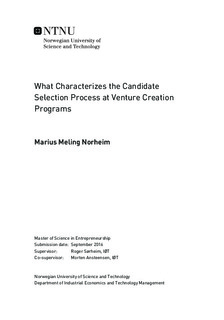What Characterizes the Candidate Selection Process at Venture Creation Programs
Master thesis
Permanent lenke
http://hdl.handle.net/11250/2441156Utgivelsesdato
2016Metadata
Vis full innførselSamlinger
Sammendrag
Abstract
Purpose - There are an increasing number of entrepreneurship educations at universities and a specific type of education where the students learn entrepreneurship through actual venture creation are called venture creation programs (VCPs). Existing research on VCPs is limited and has focused on what happens before, during and after the program. However the process of how students are selected for VCPs is currently a black box . Thus the purpose of this thesis is to investigate the process with the aim of helping the VCPs improve their selection by answering the research question: What characterizes the candidate selection process at venture creation programs?
Method - A literature review of existing research on entrepreneurship education and personnel selection was performed. Empirical data was collected through a case study of two venture creation programs in the Nordic region, which investigated their selection process.
Findings - VCP selectors face unique challenges such as a lack of specific job requirements and that candidates lack experience. The VCP faculty believed that ideal candidates did not exist and were found to assess how candidates fit the program through explicit and implicit criteria that matched the candidate s supplementary knowledge, skills, abilities and other characteristics (KSAOs). However, because ventures created by interdisciplinary teams are a key characteristic of VCPs there also existed complementary KSAOs or criteria that were considered to ensure heterogeneity in the candidate mix. Application forms followed by semi-structured interviews were used as assessment methods at both VCPs to collect information on the criteria. CSE used a mechanical composite, while NSE used a judgmental composite for collecting and combining assessment method data.
Implications - The thesis interprets person-environment fit into a VCP context and enhances our understanding of how the unique challenges and characteristics of VCPs affect their selection process through the development of the Person-VCP concept. The conceptual model presented in this thesis can potentially aid the managers and faculty at VCPs to improve their selection processes.
